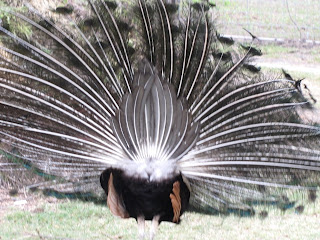 |
| Imagine my surprise to see such a colorful bird strolling along. |
(meaning our place.)
Back to the Zoo
We’re not actually raising any of these interesting animals but our neighbors are. One neighbor has had donkeys for as long as I can remember. Now they are down to one donkey and a peacock. Our other neighbor has/had chickens. Most recently their rooster was a common sight roaming the greenhouses and grounds.
The rooster has since disappeared – he may have gone on to fulfill a higher purpose for our neighbor – he was pretty plump last time I saw him.
 |
| The peacock put on quite a show for Herbie's enjoyment. |
Not knowing much about peacocks, I googled online. According to the National Geographic website's Fast Facts: peacocks are omnivores with an average life span in the wild of 20 years. They are “ground-feeders that eat insects, plants, and small creatures.” (hopefully not weenier doggies)
I can surely vouch that they have a very distinctive call that can be heard early in the morning and throughout the day.
According to TropicalBirds.com, peacocks can grow to 50 yrs of age. They need adequate perch and roosting room. The neighbor's peacock seemed to enjoy being perched on our compost pile, the fence and in the fenced back yard. I guess that’s why the peacock likes our area so much as there are lots of places to perch, and yes, they can fly.
Herbie and Daisy curiously checked him out but didn't bother getting too close. You might say the peacock kept Herbie a tail length away. His tail seemed to be a good 5 feet long. “The tails (in males) molt every August. A male adult peacock takes three years to develop the full birds eye tail span.”
 Facts about Indian Peacocks by Rosemary Drisdelle explains the bird with the beautiful display of feathers is the male peacock. Females are called peahens and babies are called peachicks. Driselle explains they “can live for at least 15 years in captivity but probably not that long in the wild.” Following is an excerpt of history, facts and little more about them that she listed:
Facts about Indian Peacocks by Rosemary Drisdelle explains the bird with the beautiful display of feathers is the male peacock. Females are called peahens and babies are called peachicks. Driselle explains they “can live for at least 15 years in captivity but probably not that long in the wild.” Following is an excerpt of history, facts and little more about them that she listed:Interesting Info
• The natural habitat of peafowl is dry open forest. The birds remain on the ground most of the time and do not fly long distances.
• In the wild, peafowl nest and feed on the ground, but roost high in the trees, ascending early in the evening.
• The eerie call of the peafowl is often heard when rain is approaching.
• Peafowl tend not to get on well with other domestic animals.
• Peafowl eat insects, seeds, plant seedlings, fruit, and small reptiles.
• Because of their taste for seeds and insects, peacocks and peahens are drawn to gardens and compost piles, where they can become a nuisance.
Driselle also explained that “domestic peafowl are valued in India because they eat young cobras.” I feel safer already.
 |
| The End |
